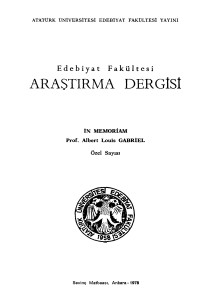Öz
Ottoman ardıitecture reached its classical and most prolific period during the reign of Süleyman the Magnificent. In this paper I shall discuss a number of majör architectural monuments sponsored by Süleyman I. However, I wil be looking not so much at the buildings themselves, as at the fact that they were put up at particular times and places. The construction of these buildings can be discussed in terms of political process. I will view their patronage, monumental quality and the use of architectural elements as acts of statescret — acts which are as fundamentally political as is the levying of taxes, the drafting of soldiers or the vvaging of war.
Anahtar Kelimeler
Kaynakça
- M. Akdağ, Türk. Halkının Dirlik ve Düzenlik Davası; Celali İsyanları, Ankara: Bilgi Yayınları, 1975.
- M. Akdağ, Türkiye’nin İktisadi ve İçtimai Tarihi, Cilt II, İstanbul: Cem Yayınevi (Kültür Dizisi), 1974.
- Ö. L. Barkan, Süleymaniye Cami ve İmareti İnşaatı (1550-57), Ankara: Türk Tarih Kurumu Yayınlarından, VI. Seri, 1972.
- G. Goodvvin, in A History of Ottoman Architecture, Baltimore: The Johns Hopkins University Press, 1971.
- H. İnalcık, The Ottoman Empire, The Classical Age, 1300-1600, New York & Washington, D.C.: Praeger Publishers, 1973.
- M. Çizakça, «Reflection of the European Price Revolution in the 16th Century Ottoman Silk Industry», paper read at the Middle East Studies Association Meetings, Los Angeles, November, 1976.
- M. Tayyib Gökbilgin, «Süleyman I,» in: İslâm Ansiklopedisi, İstanbul: 1970.
- D. Cantemir, The History of the Growth and Decay of the Othman Empire ,part I: 1300-1683, trans. N. Tindal, London: 1734.
- İbrahim Peçevi, Peçevi Tarihi, trans. Murat Uraz, İstanbul: Neşriyat Yurdu, 1968.
Öz
Ottoman ardıitecture reached its classical and most prolific period during the reign of Süleyman the Magnificent. In this paper I shall discuss a number of majör architectural monuments sponsored by Süleyman I. However, I wil be looking not so much at the buildings themselves, as at the fact that they were put up at particular times and places. The construction of these buildings can be discussed in terms of political process. I will view their patronage, monumental quality and the use of architectural elements as acts of statescret — acts which are as fundamentally political as is the levying of taxes, the drafting of soldiers or the vvaging of war.
Anahtar Kelimeler
Kaynakça
- M. Akdağ, Türk. Halkının Dirlik ve Düzenlik Davası; Celali İsyanları, Ankara: Bilgi Yayınları, 1975.
- M. Akdağ, Türkiye’nin İktisadi ve İçtimai Tarihi, Cilt II, İstanbul: Cem Yayınevi (Kültür Dizisi), 1974.
- Ö. L. Barkan, Süleymaniye Cami ve İmareti İnşaatı (1550-57), Ankara: Türk Tarih Kurumu Yayınlarından, VI. Seri, 1972.
- G. Goodvvin, in A History of Ottoman Architecture, Baltimore: The Johns Hopkins University Press, 1971.
- H. İnalcık, The Ottoman Empire, The Classical Age, 1300-1600, New York & Washington, D.C.: Praeger Publishers, 1973.
- M. Çizakça, «Reflection of the European Price Revolution in the 16th Century Ottoman Silk Industry», paper read at the Middle East Studies Association Meetings, Los Angeles, November, 1976.
- M. Tayyib Gökbilgin, «Süleyman I,» in: İslâm Ansiklopedisi, İstanbul: 1970.
- D. Cantemir, The History of the Growth and Decay of the Othman Empire ,part I: 1300-1683, trans. N. Tindal, London: 1734.
- İbrahim Peçevi, Peçevi Tarihi, trans. Murat Uraz, İstanbul: Neşriyat Yurdu, 1968.
Ayrıntılar
| Birincil Dil | İngilizce |
|---|---|
| Konular | Osmanlı Kültür ve Sanatı, Osmanlı Kurumları ve Medeniyeti (Diğer) |
| Bölüm | Araştırma Makaleleri |
| Yazarlar | |
| Yayımlanma Tarihi | 4 Mart 2024 |
| Yayımlandığı Sayı | Yıl 1978 Sayı: 9 |
Bu eser Creative Commons Atıf-GayriTicari 4.0 Uluslararası Lisansı ile lisanslanmıştır.


